
Wine Culture and Information since 2002 - Volume 22
 Wine Culture and Information since 2002 - Volume 22 |
|
Issue 27, February 2005 |
Contents |
|
|
Wine and Fruit |
|
One of the most frequent comments expressed by our readers in the letters we receive, is about the usage of casks and barriques in wines. Many complain the fact that too often the organoleptic character “forced” by wood in wine is exaggerated, therefore making many wines similar to each other even in case they are produced with different grapes. Moreover, many of our readers ask whether it still makes sense to talk about fruity character in wines when too often this organoleptic quality is simply covered or masked by the effects of the aging in wood. Moreover - still according to the comments of our readers - the habit of exaggerating with the use of cask and barriques is becoming pretty common even in white wines and - they say - in particular in those wines which do not have enough character to stand to the meeting with wood. Premising the subject “taste of wood in wines” has always had its convinced supporters - as well as convinced opposers - it is always and however good to remember that when talking about the taste of individuals, no theory is absolute or agreeable. There are wine lovers who like the character of wood - even in case it is strongly present - and others who do not tolerate any presence of wood in wines, even in case it is just a little. De Gustibus Non Est Disputandum (there is no dispute about tastes), taught us our ancestors lived in the Middle Age - no matter it is an ancient saying it is however and still valid - however, in this case, we believe it is more appropriate to remember that In Medio Stat Virtus (the virtue is in the middle). The advantages and benefits of casks in wine making are absolutely indisputable and in particular for some wines: this does not mean that a more intense or extreme use is highly beneficial to wine. It would be advisable an intelligent use of cask, where the “intelligent” word means something different according to one's own preference. After all, too much and too little are absolutely relative concepts. Taste and benefits of wood in wine apart, perhaps something true in the comments of our readers really exists. Sometimes the organoleptic qualities of wood are so strong to cover the very nature of the grape and - at the same time - some defects that even the less experienced noses could detect. Moreover, no matter it is absolutely true every type of wood used for the construction of casks gives its proper aromas to wine - the aroma of American oak is different from Allier oak - it is undeniable the excessive use of wood contributes to equalize the characteristics of wines. In this sense, our readers are probably right when they say whether it still makes sense to talk about fruit in wines. By premising the definition of fruity wine is pretty generic - while recognizing the common use of this expression - it usually refers to a wines whose aromas and tastes directly resemble the ones of fruits. No matter its definition is generic and vague, it is however desirable every wine is fruity, because - we should not forget - it is produced by a fruit, the grape, therefore the opposite would be very preoccupying. Some wines, deprived from their fruity character, would become absolutely anonymous and would lose any kind of interest in case they would be aged in cask or barrique. It would be enough to think to what the renowned white wines from Alsace or Riesling from Rhine would become in case producers would decide to have these wines intensively aged in cask. They would lose all their personality and uniqueness and would be confused in a pretty large group of anonymous wines all similar, all the same. However the quantity of wines aged or fermented in wood casks - even whites - is so high that this could make us think besides the undeniable beneficial effects of this tool, there also are other reasons. Maybe it is good to ask ourselves whether the so called fruity wines still make sense or whether they still meet the taste of consumers. Producers frequently remind us their most commercial successful wines are the ones aged in casks. If we consider this factor and we uniquely see this according to a commercial point of view, producers simply try to satisfy market's requests. After all, we cannot complain to them the fact that besides the pleasure of making wine there should also be a profit. Let's be sincere. Without having the intention of accusing anyone, how many times we heard of a wine having superior and important qualities just for the simple fact it was “passed in barrique”, and even by creating the magic - as well as horrible - adjective barriqued to be exclusively used for the best wines? Many more times than we heard this for fruity wines for sure. We repeated this so many times - as well as for making things clear - we have nothing against the cask or the barrique. It would be truly stupid to begin a battle against this because - and above all - the effects of the passage in wood of wines are undeniable as well as positive. Moreover, many prestigious and renowned wines would not be what they are without the positive contribution of the aging and the fermentation in cask. As we decided to be sincere, it is undeniable the contribution of wood gives wine very pleasing and positive organoleptic qualities, of course, when this factor is balanced and appropriate. Wines aged in wood are usually more immediate to drink and meet the taste of modern consumers easily, maybe because they are mainly attracted by the illusion of drinking something important. Is it then possible that for fruity wines there is no place among the preference of consumers anymore? Nevertheless it is possible to make truly amazing wines even without making use of any cask - and in many cases they are also better - while giving fruit the main role. Alsace - as to mention an example of a renowned area - would suggest so many wines that would make us remember about the magnificence and agreeability of a wine which tastes like fruit. A wine is considered good - first of all - for the lack of faults, a condition which allows its qualities to emerge and to be appreciated at their best. Without the presence of supplementary helps - such as the cask and its aromas that could cover many defects - making a great wine means - first of all - to make it in an unexceptionable way, with no faults and with the availability of excellent environmental and productive conditions: it is easier to say than to do. This presupposition is true - of course - in Alsace as well as in any other part of the world. Whether the use of cask and barrique is frequently exaggerated, this is certainly true - according to subjectivity, of course - anyway it is also true their use ensures a higher success among consumers. Maybe the problem of fruity wines is just a cultural issue, a common prejudice spread with precise interests in order to favor some wines and to which many believe. Maybe, in order to discover the sense and the pleasure of fruity wines again, it simply takes a better awareness in consumers as to be wondered about a wine that would make them say «Wow! It tastes like fruit!».
|
||||
MailBox |
|
In this column are published our reader's mail. If you have any comment or any
question or just want to express your opinion about wine, send your letters to
our editorial or fill in
the form available at
our site.
|
| Swirling the content of a glass is a technique commonly used for the development of aromas or bouquet. In what type of wine or distillate it is not recommended to use this technique as this also accentuates the perception of alcohol? |
| Thomas Cancienne -- Metairie, Louisiana (USA) |
| During the tasting of wines - as well as of distillates - swirling a glass allows aromas to emerge from the surface therefore making their perception to the nose possible. The aromatic molecules are generally classified according to a “weight”, that is to their level of volatility. The “heavier” substances - for example - need a higher oxygenation by means of a more stronger swirling of the glass, as well as particular physical conditions, such as temperature. It will be the glass - with its shape and geometric ratios between volume and surface of contact - to determine the quantity and the intensity of aromatic components to the nose. This explains the reason why every wine - or distillate - requires a glass with specific physical qualities in order to accentuate or attenuate its aromas or part of them. If we consider, for example, the typical grappa glass - the renowned Italian distillate - we notice its shape is pretty narrow and tall. The reduced surface of contact does not allow alcohol to excessively develop, moreover the height of the glass keeps the nose at a distance therefore avoiding its burning intensity while attenuating its perception. By using this type of glass, the distillate can be swirled while avoiding an excessive development of alcohol's aromas while continuing to appreciate the other aromatic qualities. Finally, it is good to remember that alcohol, by volatilizing from the surface of wine or distillate, also transports with it other aromatic substances therefore favoring their perception. |
| First of all, congratulations for your magazine which I read with interest since the first issue and which I spread among my friend as soon as I have the opportunity. I would like to ask this question: is there any scientific reason, or however recognized, in the common tradition of bottling wine during the period of waning moon? |
| Sergio Beretta -- Milan (Italy) |
| We do now know of any scientific explanation about the common tradition of bottling wine during the period of waning moon. It is however undeniable the gravitational action of the moon influences earth, such as in case of tides, a phenomenon discovered by Isaac Newton. It is however hard to believe any effect of the moon in wine, at least according to scientific criteria. Anyway, this tradition has very ancient origins passed up to nowadays - as well as all the other ones related to moon and agriculture - and he reason probably is astrological instead of scientific or practical. Since the times of the renowned School of Salerno it was recommended to bottle wine according to the course of moon, preferably in March or in August (lunarum cursum sequere, id est martium praecipue, vel augustum). It is however true - even though not in scientific terms but in practice - the tradition which recommends to decant or bottle wine during dry and cold days with high barometric pressure. In these conditions substances in suspension are more hardly found in wine, whereas with low barometric pressure, small gas bubbles tend to develop therefore transporting sediments to the surface. |
PortThe great fortified Portuguese wine, which in the past played a leading commercial role, still today keeps its charm and its elegance in many different styles |
|
Portuguese enology, no matter in recent times is being pretty successful in the world for the production of very good table wines, is still today indissolubly associated to its most renowned wine: Port. This wine made famous both the area in which it is produced - the Douro Valley - as well as the city from which it took its name. In fact, Port wine was named after the city of Oporto, located in the mouth of Douro river in the Atlantic coast, because it was right in this port city the wine was shipped all over the world and - in particular - in England. In past times Port was shipped to Oporto by using the characteristic boats - locally called barcos - along the Douro river to the city of Vila Nova de Gaia where they were aged taking advantage of the oceanic climate. Even today many Port producers ship their wines to Vila Nova de Gaia, however instead of the romantic boats, today are used trucks. Despite in the world are being produced other wines in the style of Port, sometimes even using the same name, nothing compares to the genuine Port made in Portugal in the Douro Valley. As it happened for Jerez (Sherry), Madeira and Marsala - the other renowned fortified wines - even the fortune and history of Port is strongly connected to the one of English merchants and still today many of the famous brands carry their names. When at the end of the seventeenth century English merchants began to find alternatives to highly taxed French products, they landed on the coastal cities of Portugal therefore starting flourishing commercial relationships, most of the times affecting the development. The Portuguese wine - as well as Port - represented the alternative to French wine and English merchants started strong relationships both with viticulturists and with bottlers. Many of them even moved to Portugal therefore becoming themselves Port producers and still today they play a relevant role in the trading and in the production of this wine.
It is more likely the first Portuguese wine the English “discovered” was Vinho Verde, typical of the northern and coastal part of Portugal, and it was only when they began to enter the internal territory, up to the Douro Valley, they “discovered” the robust wines they were looking for. These wines, because of the high continental temperatures, fermented very quickly and in a tumultuous way, producing astringent and very colored wines. From the inside areas of Portugal, these wines were transported to the coast and from there they were shipped in England. In order to keep wines from the stress of the journey, many merchants added to the barrels a small quantity of brandy - about 3% - a trick that was also used later for Marsala. However it was not this system who contributed to the origin of Port in the way we know it today, even though the discovery of its production system is still today uncertain between history and legend. The most famous legend about the discovery of Port has two English merchants and one monk. It is said about the end of the 1670's, two young English merchants were searching for wines suited for the English market. After some time, the two merchants arrived in a monastery near the city of Lamego, near the Douro river. Here a monk offered them a sweet, rich and smooth wine, very different from the one to which they were used to and they found it excellent. After having longly insisted, the monk confessed them that wine was produced by adding some brandy to the fermenting must, a condition which allowed to keep natural sweetness as well as adding alcohol. In other words he fortified the must, a technique still used today for the production of Port wine as well as many renowned French Vin Doux Naturels. Whether this event is a legend or reality, it is still today hard to tell. The events passed by history tell the Port was born in very different circumstances. The 1820 vintage produced extremely rich and sweet grapes which allowed the production of an extremely rich, concentrated, smooth and naturally sweet wine, an event which literally boosted the trade of the wine. The success was so high that Port merchants - in the hope of emulating the same commercial fortune - the following year tried to remake that very same wine, of course by using very different grapes. They decided to add a high quantity of brandy to the fermenting must in order to stop the fermentation, keeping sweetness and at the same time increasing the alcohol level. The idea worked and it was again a great success: sweet, concentrated and richly colored Port was born. In the course of years the technique was improved, the quantity of brandy used for the fortification was increased, therefore creating that unmistakable style of Port - sweet and concentrated - appreciated and looked for still today. The Douro valley - the suggestive area in which are planted the vineyards from which it is produced Port - is a very hard region for viticulturists. The sides of the hills sloping down to the course of the river, are so steep that vineyards are cultivated in terraces specifically dug in the soil. The inclination of sides can also be of 70 degrees and the difficulties of harvest are also worsened by the torrid summertime temperatures, period in which the grapes are being harvested. The soil is composed by schist and granitic, a condition which forces the vine to set its root very deep in order to search for water. The torrid climate conditions of Douro valley forced Port producers to transport their young wines - sailing the course of Douro river with the traditional barcos - to Vila Nova de Gaia, in the Atlantic coast, in order to ensure a more adequate climate for the aging, a practice that was mandatory by law until 1985. Despite this is not mandatory anymore, even today many producers prefer having their Port wines aged in the cellars at Vila Nova de Gaia, however the transport is today done by using trucks which replaced the traditional barcos.
|
||||||||
|
Port is a complex and charming wine, produced in many styles - precisely eleven - each having its own personality. According to a technical point of view, Port is a fortified wine, that is a wine to which is added some quantity of brandy during its production. The first classification of Port derives from the way it was aged: Port mainly aged in large containers - wood casks or inert tanks made of steel or concrete - and Port mainly aged in bottle. Port wines aged in large containers are destined to a more or less immediate consumption and do not require any other aging in bottle. Port mainly aged in bottle spend a short period of time in wood casks and then are bottled and aged for very long periods, even tens of years. The most representative Port of this category - as well as the most looked for - is Port Vintage. Ports aged in bottle - as time passes by - tend to throw huge amounts of sediments, therefore decanting is always necessary. Among the styles of Port, the one which is very different from all the others is White Port. Produced with white berried grapes - including Códega, Gouveio, Malvasia Fina, Rabigato and Viosinho - this style of Port is considered a lesser wine from Port lovers and it does not have the same fame and prestige of red Ports. White Ports undergo a short period of aging in cask or in large containers, and most of them have a sweet taste, sometimes very sweet - the so called lagrima - as well as an off-dry style, called leve seco. The most simple style of red Ports certainly is Ruby Port. This style of Port is produced by blending young Ports of different vintages, aged in casks or in steel tanks from one to three years. Ruby Ports are characterized by intense colors - hence the name - and pretty fruity organoleptic qualities, generally produced with grapes cultivated in less prestigious areas. Tawny Port - not to be confused with Aged Tawny Ports - are wines aged for not more than three years, therefore pretty young and usually produced with grapes cultivated in lesser prestigious areas. Their color is generally pale garnet red and are more transparent than Ruby Ports, because of a shorter period of maceration of the must in skins or - more frequently - because of the adding of White Port. Aged Tawny Port - which can be recognized by the number of years of aging written in the label - represent a very appreciated style of Port and are generally aged for 10, 20 or 30 years and even more than 40 years. Aged Tawny Ports are produced by blending wines of different vintages and aged for many years, period in which develop pretty complex aromas and the intense ruby red color gets into a red brownish color - that is tawny - hence the name. Indeed, the designation of the years of aging is defined by the average age of all wines used in the blend and determined by their taste. This means that a 20 years Tawny Port has a taste similar to a Port wine aged for about 20 years. Aged Tawny Ports are however produced with high quality wines and they usually are destined to the production of Vintage Port, a very looked for and appreciated style. A very rare style of aged Tawny Port is Colheita (meaning harvest in Portuguese) which is exclusively produced with wines of the same vintage. Colheitas must have at least seven years of aging, however the most frequent production is about wines aged for some tens of years, even more than fifty. Despite aged Tawny Ports are excellent and appreciated products, the most looked for and enchanting style is the so called Vintage. The term vintage usually refers to a wine produced with grapes harvested in the very same year, however this term is also used in a style which can be origin of confusion. Vintage Character Port is a wine resembling the style of real vintages, however it is produced with wines of good quality and of different years usually aged in cask from four to six years. In order to increase complexity, sometimes in these wines are also added Ports from older vintages. Late Bottled Vintage Port - abbreviated as LBV - is a wine produced with grapes coming from the same vintage and aged in cask from four to six years. As opposed to real vintage, this style of Port is produced every year and generally filtered, therefore with an aging in bottle, it will hardly throw sediments. Traditional Late Bottled Vintage Port is produced with grapes from the same vintage and officially declared by the producer as vintage and therefore of higher quality. Wines belonging to this category ages four years in cask - two years more than real vintages - and generally are not filtered, therefore tend to throw sediments to the bottom of the bottle. Among all styles of Port, the one which has always caught the interest of Port lovers is undoubtedly Vintage Port. These wines are exclusively produced in exceptional years and in pretty limited quantities, last but not the least, they are also pretty expensive. The grapes used for their production come from the best Douro areas, a factor which increases their quality as well. Vintage Port are aged in cask for two years, then they are bottled and from this moment begins their real evolution. During the course of years this Port slowly ages while throwing huge quantities of sediments, for this reason it is always advised to decant Vintage Port before consumption. Generally speaking, these wines are aged in bottle for about ten years, a period which is considered adequate, however longer period are pretty common as well. Single Quinta Vintage Port represents the highest qualitative style of all Ports. The term Quinta - whose literary meaning is farm - refers to a single vineyard or estate, therefore these Ports are exclusively produced with grapes harvested in vineyards of particular value. Single Quinta Vintage Port are produced in even lesser quantities than vintage and therefore they are more rare and expensive. Among the lesser known styles is found the Crusted Port, name derived from the English word crust whose meaning is sediment. These wines are produced by blending wines belonging to many vintages - with an average aging time of four years - and bottled non filtered. These Ports tend, with the aging in bottle, to throw a pretty good quantity of sediments - hence the name - and therefore require decanting. Another style produced in very limited quantities is Garrafeira Port (from Portuguese Garrafa whose meaning is bottle). These Ports are uniquely produced with grapes of a single year, considered exceptional, just like vintage. Garrafeiras are being aged in cask for a pretty short period of time, then are transferred in large glass containers - called bonbonnes - in which are being aged for tens of years, generally from twenty to forty. At the end of this period, the wine is bottled in regular bottles and therefore commercialized.
|
||||
|
As already mentioned, Ports are produced as white and red. White Ports are generally produced with the grapes Códega, Gouveio, Malvasia Fina, Rabigato and Viosinho, whereas for red Ports are used the grapes Touriga Nacional, Tinta Barroca, Tinta Roriz (known in Spain as Tempranillo), Tinto Cão and Touriga Francesa. The grapes used for the production of Port are traditionally pressed for many hours by feet in concrete tanks called lagares. This operation allow the extraction of huge quantities of color from the skins, avoids the breaking of pips and the skins can macerate in the juice in order to extract their aromatic substances. Despite few producers still use this method for their best Ports, today this procedure is done by means of machines. After about 24 hours of maceration of the skins in the must, the fermentation begins therefore converting sugar into alcohol, just like in any other wine. As soon as about the half of sugar has been converted into alcohol, the fermentation is interrupted by adding some grape brandy until reaching an alcoholic percentage of about 20%. The adding of alcohol definitively stops the action of yeast while leaving a good quantity of sugar which will give the wine its typical sweetness. The next production phases depend on the style of Port to be made and in each of them will be adopted the specific aging practices according to each specific style.
|
Chenin BlancOriginating from the Loire Valley, Chenin Blanc is a grape with a twin personality, frequently used for the production of ordinary wines, it is also capable of giving full bodied and longeval white wines |
|
Chenin Blanc probably is among the most underrated grapes of the worldwide wine scene. The many and too much interpretations of the past contributed to this deprecable noble image, in times when it was generally used for the production of ordinary wines. The excessive use of sulfur dioxide and its high productivity have contributed to the production of huge quantities and pretty ordinary qualities. Indeed wines produced with Chenin Blanc - at least in cases it is properly used - are capable of long period of aging in bottle, so long that they can even compete with Riesling, probably the most longeval white berried grape in the world. Chenin Blanc is a pretty versatile grape, maybe too much, and this quality has negatively contributed to its popularity. Nevertheless in the best interpretations this grape is capable of giving wines with interesting organoleptic qualities, from dry wines to sweet and botrytized ones, and even sparkling wines. The name of this grape derives from Mont-Chenin, in the district of Touraine, and it is probably dated back to the fifteenth century. The sure origins of Chenin Blanc are however older than that and there are evidences of this grape in the Anjou area - in the Loire Valley - since 845 AD. The main organoleptic characteristic of Chenin Blanc is acidity - probably second to Riesling only - a thin skin and a pretty high quantity of natural sugar, qualities which make it very suited for the production of sparkling wines and sweet wines, however the grape is also used for the production of dry wines. In favorable conditions, Chenin Blanc is very sensitive to the effects of noble rot - the renowned Botrytis Cinerea - a quality which allows the production of interesting botrytized and moelleux wines, to say it like the French do. In its homeland - Loire Valley - Chenin Blanc is usually called Pineau de la Loire, whereas in South Africa, where Chenin Blanc is the most common white berried grape, is called Steen. As already mentioned, the main quality of Chenin Blanc is its natural high acidity, a characteristic this grape is capable of keeping both in cool climate areas and in warm climate ones. However in cool climate areas, such as the Loire Valley when meteorological conditions are not favorable, as well as when it is cultivated with high yields, the acidity tends to excessively prevail without being properly balanced by the other organoleptic qualities. This characteristic is considered interesting in warm climate areas - such as South Africa, the central part of California and Argentina - because it allows to have grapes with optimal levels of acidity even at full ripeness. The quantity of sugar is pretty high as well, a quality which interested producers of the past to make off-dry wines - and most of the times ordinary as well - to which were added high quantities of sulfur dioxide in order to prevent any accidental refermentation in bottle although with deprecable effects on the organoleptic qualities of wine.
The direct consequence of this production system has led many producers in the Loire Valley to uproot their Chenin Blanc vineyards in favor of other varieties, including Cabernet Franc. Nevertheless it is indisputable this grape, when properly used, shows an interesting versatility and, thanks to its acidity, Chenin Blanc is very suited to the production of sparkling wines and ensures optimal balance in sweet wines. Moreover, last but not the least, in white wines - as well as in red wines - acidity also means longevity, a quality Chenin Blanc shares with other very few white berried varieties, such as Riesling. Despite Loire Valley is the homeland of Chenin Blanc, the largest acreage cultivated with this variety are located in South Africa and California. Acreage records apart, Loire Valley remains the area from which are being produced the best wines with this grape and - in particular - in the areas of Vouvray and Touraine. Chenin Blanc is a variety which can be adapted to different climates and to different soil types and, in particular, is always capable of ensuring optimal levels of acidity and high yields. These two characteristics are very interesting for the production of bulk wines because even with high yields, Chenin Blanc ensures wines with good acidity. Just like any other grape, even Chenin Blanc prefers specific types of soil and particular climates, in which it is capable of giving extraordinary results. To these conditions it should be added a proper cultural technique for quality production that in Chenin Blanc, as well as for other grapes, must be very low and distant from the concepts of quantitative production. Chenin Blanc is a variety which tends to sprout in advance and to ripe pretty late, a cultural condition which can also be cause of problems in cool climate areas, such as in Loire Valley. Chenin Blanc is usually used for the production of monovarietal wines, however it is also frequent, even in the Loire Valley, that to this grape is added a certain quantity of Chardonnay in order to mitigate its excessive acidity. Its thin skin makes it very sensitive to the effects of noble rot, a common and looked for quality in sweet wines. The best examples of Chenin Blanc wines - in every style - are the ones exclusively produced with this grape, however it is good to remember that still today Chenin Blanc is very used for the production of bulk ordinary wines, in which the presence of sulfur dioxide is pretty evident both in the aromas and in the taste. Thanks to its acidity, quality Chenin Blanc wines are very suited to long period of aging that can also be as long as tens of years, such as in case of wines produced in the small area of Savennières, in the Loire Valley.
|
||||||||
|
The colors of wines produced with Chenin Blanc varies according to the production style. In fact, this grape is used for the production of many different styles of wines, from sparkling wines to sweet and botrytized wines. Moreover, even though this practice is pretty limited with Chenin Blanc, any possible fermentation and aging in cask influences color as well. The spreading of this grape in the world is pretty limited, however climate and ripeness influence its color. Sparkling wines produced with Chenin Blanc show colors from greenish yellow to straw yellow, a color which is also found in dry and off-dry wines. The color of sweet and botrytized wines tend to deeper hues of golden yellow, as well as in dry and off-dry wines produced in warm climate regions. With time, that in Chenin Blanc can also be some tens of years, the evolution of color is similar to other white wines and will show intense golden yellow hues at the top of its aging.
|
|
The aromatic characteristics in Chenin Blanc are strongly influenced by quality, a factor which is however and always true for every grape and for every wine. In case of Chenin Blanc, this premise is probably necessary as this grape is still today widely used for the production of bulk wines because of its high productivity and that however ensures wines with good acidity. In bulk wines aromas are pretty ordinary, almost anonymous, and which can be easily confused with all the other wines of similar quality. Chenin Blanc in order to give its best in aromas, requires quality cultural and enological practices. Wines produced in cool climate areas or with not fully ripe grapes, develop aromas of green apple, lemon, citrus fruit, acacia and, sometimes, melon. Wines produced in warm climate areas or ripe grapes, develop aromas of ripe apple, honey, lemon, peach, quince, apricot, melon and frequently aromas of grape, typical in aromatic varieties. Wines produced with Chenin Blanc are pretty suited to long aging in bottle, however it is good to remember this quality exclusively belongs to high quality wines in which the aromatic bouquet improves with time. With time Chenin Blanc wines generally develop aromas of honey, beeswax, musk, lanolin and quince jam. Wines produced with Chenin Blanc grapes affected by Botrytis Cinerea - the noble rot - besides the typical aromas derived from its effects, develop aromas of raisin, marzipan, quince jam, honey and aromas of spices. In wines produced with this grape and fermented or aged in cask - a pretty limited practice with Chenin Blanc and which is sometimes used for sweet or botrytized wines - can be perceived the typical aromas passed from wood to wine, qualities which strongly vary according to the toast level of the cask as well as to the time of aging.
|
|
The main gustatory characteristic of Chenin Blanc is acidity, a pretty strong quality and which strongly contributes to the balance of sweet wines produced with this grape. Acidity is also a quality which makes Chenin Blanc suited to the production of sparkling wines. Its wines usually have medium-high quantity of alcohol, however the most frequent percentage is of about 12.5%. The structure in wines produced with Chenin Blanc is pretty high, to be considered among the most robust in white wines. Chenin Blanc's acidity represents the main gustatory element and this quality is clearly appreciable since the first sip. To balance the high acidity contributes alcohol and, in particular, the sweetness of sweet and botrytized wines. Dry or off-dry Chenin Blanc wines are usually produced with structures from light to full bodied. In light wines crispness will be high, whereas in full bodied wines the higher structure will give a greater vigor to the wine while keeping an appreciable acidity.
|
|
The indisputable homeland of Chenin Blanc is Loire Valley - in France - and in particular in the central area. Wines from Touraine are produced in many styles, from sparkling to sweet. Wines from Savennières are pretty rare, however in the best years here are being produced high quality wines, dry and full bodied, most of the time characterized by mineral and black pepper aromas because of the volcanic soil. In the southern area of the Loire river are found the interesting Coteaux du Layon AC and Coteaux de l'Aubance AC in which are being produced off-dry and sweet wines. The most renowned sweet Chenin Blanc wines produced in the Loire Valley are the ones from Bonnezeaux and Quarts de Chaume - both located in the Coteaux de Layon area - with pretty complex characteristics, most of the times produced with grapes affected by Botrytis Cinerea. Other interesting areas for Chenin Blanc in the Loire Valley are Vouvray and Montlouis. In these areas, because of the limestone soil, are being produced lighter and less bodied wines than the ones produced in the Anjou area. Wines from Vouvray and Montlouis are appreciated for their elegance and finesse with very good organoleptic evolution with aging. Wines from Vouvray certainly are among the most famous Chenin Blanc wines from Loire Valley and frequently represent the reference model for other areas outside France in which this grape is cultivated. Chenin Blanc is also found in South Africa - here known as Steen and which represents the most cultivated grape of the country - used for the production of dry, sweet and sparkling wines. In South Africa Chenin Blanc is mainly used for the production of bulk wines, however with this grape are also produced interesting late harvest wines. Chenin Blanc is pretty common in California as well - and in particular in the Central Valley - mainly used for the production of bulk wines, most of the times added with sugar in order to balance the strong acidity. In recent times Californian producers are revaluating this grape in the aim of producing quality wines in the Vouvray style. Marginal productions of Chenin Blanc are also found in Australia and in New Zealand.
|
||||
Wines of the Month |
|
|
|
Score legend Prices are to be considered as indicative. Prices may vary according to the country or the shop where wines are bought |
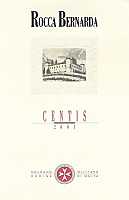
|
|
Colli Orientali del Friuli Merlot Centis 2001 |
|
| Rocca Bernarda (Italy) | |
| Grapes: Merlot | |
| Price: € 17.50 | Score: |
| This Merlot shows a brilliant ruby red color and nuances of garnet red, little transparency. The nose reveals intense, clean, pleasing and refined aromas which start with hints of black cherry, plum and black currant followed by aromas of vanilla, blueberry, bell pepper, licorice, cocoa, cinnamon and hints of hay. In the mouth has good correspondence to the nose, a slightly tannic attack and however well balanced by alcohol, full body, intense flavors, good tannins, agreeable. The finish is persistent with flavors of plum, black cherry and black currant. A well made wine. Merlot Centis is aged for 15 months in barrique followed by an aging in bottle for at least 8 months. | |
| Food Match: Braised and stewed meat, Roasted meat, Hard cheese | |
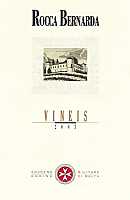
|
|
Colli Orientali del Friuli Bianco Vineis 2003 |
|
| Rocca Bernarda (Italy) | |
| Grapes: Tocai Friulano (80%), Sauvignon Blanc (10%), Chardonnay (10%) | |
| Price: € 11.00 | Score: |
| This wine shows a brilliant straw yellow color and nuances of straw yellow, very transparent. The nose denotes intense, clean, pleasing and refined aromas which start with hints of hawthorn and plum followed by aromas of pineapple, banana, apple, acacia, pear, grapefruit and hints of vanilla. In the mouth has good correspondence to the nose, a crisp attack and however balanced by alcohol, good body, intense flavors, agreeable. The finish is persistent with flavors of pear, plum and pineapple. A well made wine. The Chardonnay used for the production of this wine ferments in barrique. Vineis ages for 6 months in steel tanks. | |
| Food Match: Fried fish, Roasted fish, Broiled fish, Pasta with fish and crustaceans | |
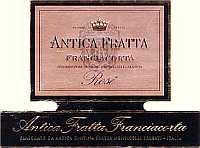
|
|
Franciacorta Rosé |
|
| Antica Fratta (Italy) | |
| Grapes: Chardonnay (60%), Pinot Noir (40%) | |
| Price: € 16.00 | Score: |
| This Franciacorta shows a pale onion skin pink and nuances of pale pink, very transparent, good effervescence, fine and persistent perlage. The nose reveals intense, clean, pleasing and refined aromas which start with hints of raspberry, cherry and bread crust followed by aromas of strawberry, banana, cyclamen, yeast, tangerine, apple and pink grapefruit. In the mouth has good correspondence to the nose, a crisp and effervescent attack, however balanced, good body, intense flavors, agreeable. The finish is persistent with flavors of raspberry, strawberry and cherry. A well made wine. This Franciacorta ages on its lees for 24 months. | |
| Food Match: Pasta and risotto with fish, Roasted fish, Sauteed white meat | |
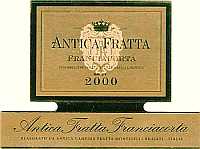
|
|
Franciacorta Brut Millesimato 2000 |
|
| Antica Fratta (Italy) | |
| Grapes: Chardonnay | |
| Price: € 18.00 | Score: |
| This Franciacorta shows a brilliant golden yellow color and nuances of golden yellow, very transparent, good effervescence, fine and persistent perlage. The nose reveals intense, clean, pleasing and refined aromas which start with hints of praline, banana and bread crust followed by aromas of acacia, hawthorn, butter, yeast, apple, kiwi and pear. In the mouth has good correspondence to the nose, a crisp and effervescent attack, however balanced, good body, intense flavors, agreeable. The finish is persistent with flavors of pear, apple and kiwi. A well made wine. This Franciacorta ages on its lees for 42 months. | |
| Food Match: Fish and mushrooms soups, Roasted fish, Stuffed pasta with meat | |
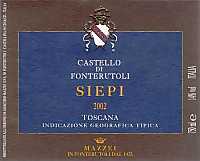
|
|
Siepi 2002 |
|
| Castello di Fonterutoli (Italy) | |
| Grapes: Merlot (70%), Sangiovese (30%) | |
| Price: € 58.00 | Score: |
| This wine shows an intense ruby red color and nuances of garnet red, little transparency. The nose reveals intense, clean, pleasing, refined and elegant aromas which start with hints of plum and black currant followed by aromas of blackberry, black cherry, blueberry, vanilla, licorice, tobacco, eucalyptus, cocoa and hints of bell pepper. In the mouth has good correspondence to the nose, a slightly tannic attack and pleasing smoothness, however well balanced by alcohol, full body, intense flavors, good tannins, agreeable. The finish is persistent with flavors of plum, black currant and black cherry. A well made wine. Siepi ages for 18 months in barrique. | |
| Food Match: Game, Roasted meat, Braised and stewed meat, Hard cheese | |
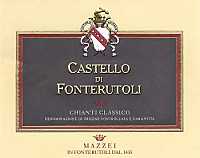
|
|
Chianti Classico Castello di Fonterutoli 2001 |
|
| Castello di Fonterutoli (Italy) | |
| Grapes: Sangiovese (85%), Cabernet Sauvignon (10%), Merlot (5%) | |
| Price: € 34.00 | Score: |
| This Chianti shows an intense ruby red color and nuances of garnet red, little transparency. The nose reveals intense, clean, pleasing and refined aromas which start with hints of black cherry, plum and blackberry followed by aromas of violet, vanilla, black currant, tobacco, licorice, cyclamen, blueberry, cocoa and eucalyptus. In the mouth has very good correspondence to the nose, a slightly tannic attack and pleasing crispness, however well balanced by alcohol, full body, intense flavors, good tannins. The finish is very persistent with long flavors of black cherry, plum and blueberry. A well made wine. This Chianti ages for 16-18 months in barrique. | |
| Food Match: Game, Roasted meat, Braised and stewed meat, Hard cheese | |
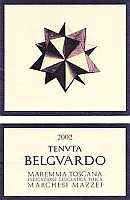
|
|
Tenuta Belguardo 2002 |
|
| Tenuta Belguardo (Italy) | |
| Grapes: Cabernet Sauvignon (70%), Sangiovese (20%), Merlot (10%) | |
| Price: € 34.50 | Score: |
| This wine shows a deep ruby red color and nuances of garnet red, little transparency. The nose reveals intense, clean, pleasing and refined aromas which start with hints of black cherry, plum and vanilla followed by aromas of blueberry, blackberry, black currant, violet, tobacco, licorice, bell pepper and cocoa. In the mouth has good correspondence to the nose, a slightly tannic attack and however well balanced by alcohol, full body, intense flavors, good tannins. The finish is persistent with flavors of plum and black cherry. A well made wine. Tenuta Belguardo ages for 18 months in cask. | |
| Food Match: Stewed and braised meat, Roasted meat, Game, Hard cheese | |
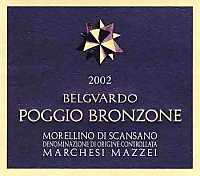
|
|
Morellino di Scansano Poggio Bronzone 2002 |
|
| Tenuta Belguardo (Italy) | |
| Grapes: Sangiovese | |
| Price: € 18.50 | Score: |
| This wine shows a brilliant ruby red color and nuances of ruby red, little transparency. The nose denotes intense, clean, pleasing and refined aromas that start with hints of black cherry and plum followed by aromas of blackberry, blueberry, violet, vanilla, licorice, tobacco and black currant. In the mouth has good correspondence to the nose, a tannic attack and however well balanced by alcohol, good body, intense flavors, good tannins, agreeable. The finish is persistent with flavors of black cherry, blueberry and plum. This wine ages in cask for 14 months. | |
| Food Match: Roasted meat, Braised and stewed meat, Hard cheese | |
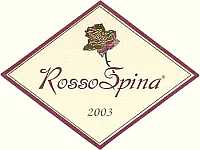
|
|
Rosso Spina 2003 |
|
| Cantina La Spina (Italy) | |
| Grapes: Montepulciano (90%), Merlot (5%), Gamay (5%) | |
| Price: € 12.00 | Score: |
| Rosso Spina shows a brilliant ruby red color and nuances of ruby red, moderate transparency. The nose denotes intense, clean, pleasing and refined aromas which start with hints of raspberry and cherry followed by aromas of cyclamen, rose, vanilla, licorice, carob and cinnamon. In the mouth has good correspondence to the nose, a slightly tannic attack and pleasing crispness, however balanced by alcohol, good body, intense flavors, good tannins, agreeable. The finish is persistent with flavors of raspberry and cherry. Rosso Spina ages in barrique for 11 months. | |
| Food Match: Roasted meat, Broiled meat and barbecue, Stewed meat, Hard cheese | |
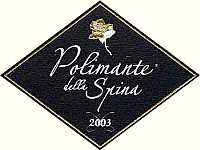
|
|
Polimante della Spina 2003 |
|
| Cantina La Spina (Italy) | |
| Grapes: Merlot (70%), Gamay (30%) | |
| Price: € 14.00 | Score: |
| This wine shows a brilliant ruby red color and nuances of ruby red, little
transparency. The nose reveals intense, clean, pleasing, refined and
elegant aroma | |
| Food Match: Game, Braised and stewed meat, Roasted meat, Hard cheese | |
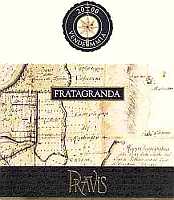
|
|
Fratagranda 2000 |
|
| Pravis (Italy) | |
| Grapes: Cabernet Sauvignon, Cabernet Franc, Merlot | |
| Price: € 15.00 | Score: |
| The wine shows a brilliant ruby red color and nuances of garnet red, moderate transparency. The nose reveals good personality with intense, clean, pleasing and refined aromas which start with hints of plum jam and black cherry jam followed by aromas of black currant, vanilla, licorice, tobacco, cocoa, mace and cinnamon. In the mouth has good correspondence to the nose, a slightly tannic attack and however well balanced by alcohol, good body, intense flavors, good tannins, agreeable. The finish is persistent with flavors of black currant and black cherry jam. A well made wine. Fratagranda ages for one year in barrique followed by six months of aging in bottle. | |
| Food Match: Roasted meat, Braised and stewed meat, Hard cheese | |
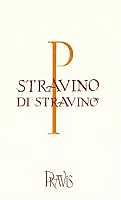
|
|
Stravino di Stravino 2002 |
|
| Pravis (Italy) | |
| Grapes: Chardonnay, Riesling, Sauvignon Blanc, Kerner, Incrocio Manzoni | |
| Price: € 18.00 | Score: |
| The wine shows an intense straw yellow color and nuances of straw yellow, very transparent. The nose reveals good personality with intense, clean, pleasing, refined and elegant aromas which start with hints of hazelnut and banana followed by aromas of apricot, butter, broom, pear, peach, raisin and hints of vanilla. In the mouth has good correspondence to the nose, a crisp attack and pleasing roundness, however well balanced by alcohol, good body, intense flavors, agreeable. The finish is persistent with flavors of peach, banana and raisin. A well made wine. Stravino di Stravino is produced with grapes harvested in different periods of which part overripe and part dried on mats, separately vinified in cask and in steel tanks. | |
| Food Match: Roasted fish with spices, Sauteed white meat, Pasta with fish and crustaceans | |
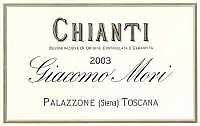
|
|
Chianti 2003 |
|
| Giacomo Mori (Italy) | |
| Grapes: Sangiovese (95%), Colorino, Canaiolo Nero (5%) | |
| Price: € 13.50 | Score: |
| This Chianti shows a brilliant ruby red color and nuances of ruby red, moderate transparency. The nose reveals intense, clean and pleasing aromas that start with hints of black cherry and plum followed by aromas of blueberry, violet, licorice and hints of vanilla. In the mouth has good correspondence to the nose, a slightly tannic attack and pleasing crispness, however balanced by alcohol, good body, intense flavors, good tannins. The finish is persistent with flavors of black cherry and plum. This Chianti ages for 10-12 in cask followed by 3-6 months of aging in bottle. | |
| Food Match: Broiled meat, Roasted meat, Stewed meat, Cheese | |
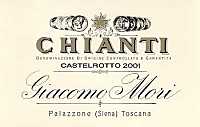
|
|
Chianti Castelrotto 2001 |
|
| Giacomo Mori (Italy) | |
| Grapes: Sangiovese (90%), Merlot (10%) | |
| Price: € 24.00 | Score: |
| This Chianti shows an intense ruby red color and nuances of garnet red, little transparency. The nose reveals intense, clean and pleasing aromas which start with hints of black cherry and plum followed by aromas of blackberry, blueberry, licorice, violet, cocoa and vanilla. In the mouth has good correspondence to the nose, a slightly tannic attack and however balanced by alcohol, good body, intense flavors, good tannins, agreeable. The finish is persistent with flavors of black cherry and plum. This Chianti ages for 15-18 months in barrique followed by 6-10 months of aging in bottle. | |
| Food Match: Roasted meat, Broiled meat, Braised and stewed meat | |
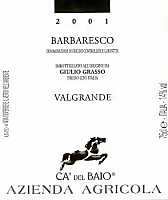
|
|
Barbaresco Valgrande 2001 |
|
| Ca' del Baio (Italy) | |
| Grapes: Nebbiolo | |
| Price: € 20.00 | Score: |
| This Barbaresco shows a brilliant ruby red color and nuanced of brick red, moderate transparency. The nose denotes intense, clean, pleasing, refined and elegant aromas that start with hints of cherry, raspberry and dried violet followed by aromas of plum, licorice, cinnamon, cinchona, tobacco, vanilla and menthol. In the mouth has good correspondence to the nose, a tannic attack and appreciable crispness, however well balanced by alcohol, full body, intense flavors, good tannins. The finish is persistent with flavors of cherry, raspberry and plum. A well made wine. This Barbaresco ages for 15 months in cask. | |
| Food Match: Game, Roasted meat, Braised and stewed meat, Hard cheese | |
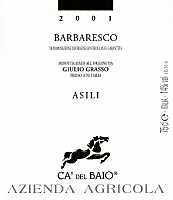
|
|
Barbaresco Asili 2001 |
|
| Ca' del Baio (Italy) | |
| Grapes: Nebbiolo | |
| Price: € 20.00 | Score: |
| This Barbaresco shows a brilliant ruby red color and nuanced of garnet red, moderate transparency. The nose reveals good personality with intense, clean, pleasing, refined and elegant aromas which start with hints of cherry and raspberry followed by aromas of rose, dried violet, lavender, licorice, tobacco, cinnamon, vanilla and menthol. In the mouth has good correspondence to the nose, a tannic attack and appreciable crispness, however well balanced by alcohol, full body, intense flavors, good tannins, agreeable. The finish is persistent with flavors of cherry and raspberry. A well made wine. This Barbaresco ages for 15 months in cask. | |
| Food Match: Game, Roasted meat, Braised and stewed meat, Hard cheese | |
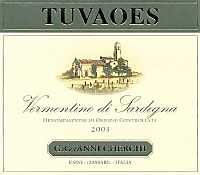
|
|
Vermentino di Sardegna Tuvaoes 2003 |
|
| Giovanni Cherchi (Italy) | |
| Grapes: Vermentino | |
| Price: € 9.00 | Score: |
| This Vermentino shows a pale straw yellow color and nuances of straw yellow, very transparent. The nose reveals intense, clean, pleasing, refined and elegant aromas which start with hints of pear, hawthorn and apple followed by aromas of pineapple, orange, broom, litchi, almond and peach. In the mouth has good correspondence to the nose, a crisp attack and however well balanced by alcohol, good body, intense flavors, agreeable. The finish is persistent with flavors of pear, peach and orange. A well made wine. A small part of the must used for the production of Tuvaoes ferments in barrique. | |
| Food Match: Fried fish, Roasted fish, Broiled fish, Roasted white meat | |
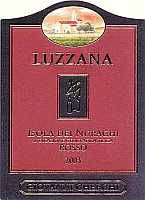
|
|
Luzzana 2002 |
|
| Giovanni Cherchi (Italy) | |
| Grapes: Cagnulari (60%), Cannonau (40%) | |
| Price: € 12.50 | Score: |
| This wine shows an intense ruby red color and nuances of ruby red, little transparency. The nose reveals intense, clean, pleasing and refined aromas which start with hints of cherry and raspberry followed by aromas of blueberry, plum, cyclamen, black currant, violet, tobacco and vanilla. In the mouth has good correspondence to the nose, a slightly tannic attack and however balanced by alcohol, good body, intense flavors, good tannins, agreeable. The finish is persistent with flavors of plum, cherry and raspberry. A well made wine. Luzzana ages for 8-12 months in barrique followed by an aging in bottle of 4 months. | |
| Food Match: Roasted meat, Braised and stewed meat, Hard cheese | |
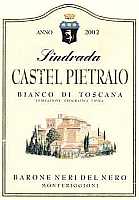
|
|
Sindrada 2003 |
|
| Fattoria di Castel Pietraio (Italy) | |
| Grapes: Chardonnay, Malvasia Bianca | |
| Price: € 6.00 | Score: |
| The wine shows a pale straw yellow color and nuances of straw yellow, very transparent. The nose denotes intense, clean and pleasing aromas which start with hints of apple and hawthorn followed by aromas of pineapple, banana, broom, pear and hints of almonds. In the mouth has good correspondence to the nose, a crisp attack and however balanced, good body, intense flavors. The finish is pretty persistent with flavors of apple and pineapple. | |
| Food Match: Risotto with vegetables, Fried fish, Fish and vegetables appetizers | |
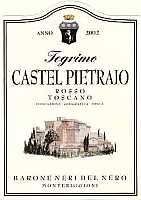
|
|
Tegrimo 2002 |
|
| Fattoria di Castel Pietraio (Italy) | |
| Grapes: Sangiovese | |
| Price: € 12.00 | Score: |
| This wine shows a brilliant ruby red color and nuances of garnet red, little transparency. The nose denotes intense, clean and pleasing aromas which start with hints of black cherry and raspberry followed by aromas of strawberry, blueberry, cyclamen, plum and hints of vanilla. In the mouth has good correspondence to the nose, a slightly tannic attack and pleasing crispness, however balanced by alcohol, good body, intense flavors, good tannins. The finish is persistent with flavors of plum, black cherry and raspberry. Tegrimo ages for 6 months in barrique. | |
| Food Match: Stewed meat with mushrooms, Broiled meat, Hard cheese | |
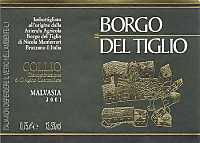
|
|
Collio Malvasia Selezione 2001 |
|
| Borgo del Tiglio (Italy) | |
| Grapes: Malvasia Istriana | |
| Price: € 35.00 | Score: |
| This wine shows a pale straw yellow color and nuances of greenish yellow, very transparent. The nose reveals good personality with intense, clean, pleasing and refined aromas that start with hints of hawthorn and apple followed by aromas of pineapple, peach, almond, plum, grapefruit, toasted wood and vanilla. In the mouth has good correspondence to the nose, a crisp attack and however balanced by alcohol, good body, intense flavors, agreeable. The finish is persistent with flavors of plum and apple. This Malvasia ages in cask. | |
| Food Match: Sauteed fish, Broiled crustaceans, Stuffed pasta with mushrooms | |
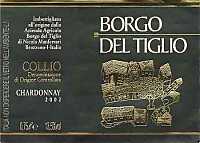
|
|
Collio Chardonnay Selezione 2002 |
|
| Borgo del Tiglio (Italy) | |
| Grapes: Chardonnay | |
| Price: € 35.00 | Score: |
| This wine shows a brilliant straw yellow color and nuances of straw yellow, very transparent. The nose denotes intense, clean, pleasing, refined and elegant aromas which start with hints of toasted wood and plum followed by aromas of hawthorn, banana, pineapple, lily, peach, hazelnut, grapefruit, lavender and vanilla. In the mouth has good correspondence to the nose, a crisp attack and pleasing smoothness, however well balanced by alcohol, good body, intense flavors, agreeable. The finish is persistent with flavors of hazelnut, plum and grapefruit. A well made wine. This Chardonnay ferments and ages in barrique for 9-14 months. | |
| Food Match: Roasted fish, Stuffed pasta, Fish and mushrooms soups, Roasted white meat | |
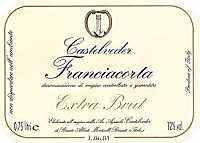
|
|
Franciacorta Extra Brut |
|
| Castelveder (Italy) | |
| Grapes: Chardonnay | |
| Price: € 9.60 | Score: |
| This Franciacorta shows a brilliant greenish yellow color and nuances of greenish yellow, very transparent, good effervescence, fine and persistent perlage. The nose reveals intense, clean, pleasing and refined aromas which start with hints of apple, kiwi and bread crust followed by aromas of hawthorn, yeast, hazelnut, plum and praline. In the mouth has good correspondence to the nose, a crisp and effervescent attack, however balanced, good body, intense flavors. The finish is persistent with flavors of kiwi, apple and plum. This Franciacorta ages on its lees for 25 months. | |
| Food Match: Fried fish, Sauteed fish and crustaceans, Pasta with fish and crustaceans | |
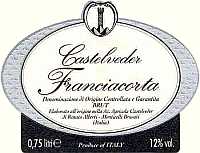
|
|
Franciacorta Brut |
|
| Castelveder (Italy) | |
| Grapes: Chardonnay | |
| Price: € 9.00 | Score: |
| This Franciacorta shows an intense straw yellow color and nuances of straw yellow, very transparent, good effervescence, fine and persistent perlage. The nose denotes intense, clean, pleasing and refined aromas which start with hints of bread crust and yeast followed by aromas of pineapple, banana, hawthorn, beeswax, apple, pear and grapefruit. In the mouth has good correspondence to the nose, a crisp and effervescent attack, however balanced, good body, intense flavors, agreeable. The finish is persistent with flavors of apple and pineapple. This Franciacorta ages on its lees for 25 months. | |
| Food Match: Pasta and risotto with fish and crustaceans, Roasted fish and crustaceans and with mushrooms | |
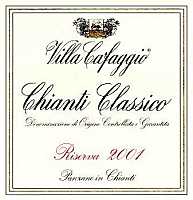
|
|
Chianti Classico Riserva 2001 |
|
| Villa Cafaggio (Italy) | |
| Grapes: Sangiovese | |
| Price: € 23.00 | Score: |
| The wine shows a brilliant ruby red color and nuances of ruby red, little transparency. The nose denotes intense, clean, pleasing and refined aromas which start with hints of plum and black cherry followed by aromas of blueberry, blackberry, violet, vanilla, black pepper, licorice and eucalyptus. In the mouth has good correspondence to the nose, a slightly tannic attack and however well balanced by alcohol, good body, intense flavors, good tannins. The finish is persistent with flavors of plum, black cherry and blueberry. This Chianti ages for 18 months in barrique followed by 5-6 months of aging in bottle. | |
| Food Match: Roasted meat, Braised and stewed meat, Hard cheese | |
Produttori Colterenzio - SchreckbichlWith more than forty years of history, today Produttori Colterenzio winery is one of the reference wine making models in Alto Adige, a success obtained thanks to the quality of its wines |
|
Despite it was established in 1960, the history of Produttori Colterenzio - Schreckbichl sets its root in ancient times, during the times of ancient Romans. In fact the vineyards of Colterenzio, are among the oldest in Europe and the Cornelianum estate - belonged to Cornelius, first Roman settler and viticulturist of the region - represents the starting point of the enological culture which had developed in the course of the centuries and culminated in the Middle Age. From Cornelius' estate derives Curilan, which 1000 years later will be called Cornaiano - or Girlan in German - the place where Produttori Colterenzio's headquarters are located. The recent history of this places began in 1960, when twenty eight wineries and estates located at Colterenzio, Cornaiano and Frangarto, decided to join their businesses therefore establishing Produttori Schreckbichl or Colterenzio winery.
As a consequence of the successes of these producers, other wineries joined the consortium in the next years and today the acreage is of about 370 hectares (about 890 acres), located in the best viticultural areas. The secret of Colterenzio's success mainly derives from the strong conviction - even since those times - that quality should have been a primary and fundamental requisite for wine making production, something which should begin from the vineyard. The winery has been run by four chairmen, however the fundamental impulse was given in 1979 when Mr. Luis Raifer was called to run the winery. Thanks to his personality, to the trust from the members as well as by introducing managerial concepts typical of private businesses, Luis Raifer has practically given a new impulse to the winery by increasing the production of bottled wine, exports and income. The hardest job of Luis Raifer certainly was to convince the members that they could make more money by working differently, mainly concentrating on grapes quality instead of quantity. Even the remuneration system of members has changed according to this innovative principle: since many years the winery pays its members not according to the sugar quantities in their grapes, but according to the yield and to the destination of the grapes for the production of the many wines. By following these presuppositions, every year Produttori Colterenzio winery ideally awards those members who have shown a particular care in providing grapes of superior quality by using their harvests for the production of the most prestigious wines and selections. The quality process begins in the vineyard and in the cultural systems - both with the traditional pergola and with the modern Guyot - used for Cabernet Sauvignon, Merlot, Sauvignon Blanc, in part for Pinot Noir and experimentally for Lagrein. All the new vineyards are planted according the Guyot system. Moreover, viticulturists benefit of technical help and support provided by the winery, such as Mr. Donato Lanati, therefore allowing them to be continuously up to date by means of an exchange of experiences and information about the production of wine.
Produttori Colterenzio winery aims to obtain specific and precise productive norms, such as the reduction of yields by means of accurate pruning in wintertime and specific lopping; use of nutritional substances of organic origin by planting leguminous plants and specific herbaceous blends; limitation of anti-parasite treatments in order not to harm useful insects; planting of clones with low yields per hectare in order to avoid molds while increasing quality. The selection of grapes continues in the winery at the moment in which they are provided by members. Grapes are being classified according to their quality and the ones which do not obey to strict and specific criteria - not perfectly ripe or rotten grapes - are excluded. The grape is also classified in order to determine its destination for the production of wines and blends. It should also be observed that at Produttori Colterenzio the selection of grape is done by means of tasting in order to define not only its quality but also its organoleptic characteristics. Produttori Colterenzio's vineyards are located in many areas of Alto Adige, at different altitudes and cultivated in different soils and microclimates. From the area of Cornaiano and Appiano Monte - at an altitude of 400-600 meters (1300-2000 feet) - are generally cultivated white berried grapes, such as Pinot Blanc, Chardonnay and Pinot Gris. From the area of Settequerce - near Terlan - and Gries, in the neighboring of Bozen, are cultivated red berried grapes used for full bodied wines, such as Merlot, Cabernet Sauvignon and Lagrein. In the sunny hills of Cornaiano are found the vineyards of Sauvignon Blanc, Pinot Noir, Schiava and Gewürztraminer. Having vineyards in such a wide and diverse area - which from Salorno and Settequerce goes to the valley of Santa Maddalena, near Bozen - lets Produttori Colterenzio winery to use grapes cultivated in different microclimates and with different times of ripeness, therefore increasing the variety and personality of wines. Produttori Colterenzio winery, by applying its productive philosophy, always aims to get the best possible quality, in every condition and with every grape, either autochthonous or international. The winery uses fermentation tanks which allow a constant control of temperature, particularly suited for the fermentation of white wines in order to allow them to completely express their varietal character. Red wines are being aged in casks of different sizes, according to the style of wine to be obtained and according to the variety. The aging of special wines is done in barrique, and after months of aging are bottled both as monovarietals and used for the making of the winery's blends, now famous worldwide. In the philosophy of Produttori Colterenzio making wine means having the consciousness and the pleasure of making a product, direct expression of its homeland, capable of communicating, as every wine, even the most ambitious and important one, is always made in order to be drunk with joy, to give emotions and sensations to the ones who uncork the bottle. Indeed - in Colterenzio's wines - one truly has the idea this philosophy is confirmed in the glass.
|
||||||||||||||||||||
|
Score legend Prices are to be considered as indicative. Prices may vary according to the country or the shop where wines are bought |
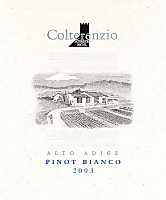
|
|
Alto Adige Pinot Bianco 2003 |
|
| Produttori Colterenzio (Italy) | |
| Grapes: Pinot Blanc | |
| Price: € 5.80 | Score: |
| The wine shows an intense greenish yellow color and nuances of greenish yellow, very transparent. The nose denotes intense, clean, pleasing and refined aromas that start with hints of apple, pear and peach followed by aromas of melon, lily, hawthorn and pineapple. In the mouth has good correspondence to the nose, a crisp attack and however balanced, good body, intense flavors, agreeable. The finish is persistent with flavors of pear, peach and apple. This Pinot Blanc ages in steel tanks. | |
| Food Match: Fried fish, Fish and crustaceans appetizers, Risotto with fish and crustaceans | |
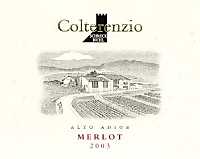
|
|
Alto Adige Merlot 2003 |
|
| Produttori Colterenzio (Italy) | |
| Grapes: Merlot | |
| Price: € 6.10 | Score: |
| The wine shows a brilliant ruby red color and nuances of ruby red, little transparency. The nose reveals intense, clean, pleasing and refined aromas that start with hints of black cherry, raspberry and plum followed by aromas of blueberry, cyclamen, menthol and hints of bell pepper and vanilla. In the mouth has good correspondence to the nose, a slightly tannic attack and however balanced by alcohol, good body, intense flavors, good tannins. The finish is persistent with flavors of black cherry, plum and raspberry. Part of this Merlot ages for 6 months in cask followed by 5-6 of aging in bottle. | |
| Food Match: Broiled meat and barbecue, Sauteed meat with mushrooms, Roasted meat, Cheese | |
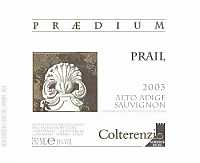
|
|
Alto Adige Sauvignon Prail Praedium 2003 |
|
| Produttori Colterenzio (Italy) | |
| Grapes: Sauvignon Blanc | |
| Price: € 10.00 | Score: |
| This wine shows a pale straw yellow color and nuances of greenish yellow, very transparent. The nose denotes intense, clean, pleasing, refined and elegant aromas which start with hints of peach and elder followed by aromas of pineapple, acacia, litchi, grape, pear and hints of sage and tomato leaf. In the mouth has good correspondence to the nose, a crisp attack and however balanced by alcohol, good body, intense flavors, agreeable. The finish is persistent with flavors of peach, pear and litchi. A well made wine. This Sauvignon Blanc ages in steel tanks. | |
| Food Match: Asparagus, Fried fish, Crustaceans, Pasta and risotto with fish and vegetables | |
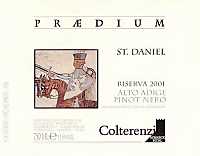
|
|
Alto Adige Pinot Nero Riserva St. Daniel Praedium 2001 |
|
| Produttori Colterenzio (Italy) | |
| Grapes: Pinot Noir | |
| Price: € 12.30 | Score: |
| This Pinot Noir shows a pale ruby red color and nuances of garnet red, moderate transparency. The nose reveals intense, clean, pleasing and refined aromas which start with hints of cherry, raspberry and vanilla followed by aromas of strawberry, plum, dried rose and licorice. In the mouth has good correspondence to the nose, a pleasing crisp and tannic attack, however balanced by alcohol, good body, intense flavors, agreeable. The finish is persistent with flavors of cherry, raspberry and strawberry. This Pinot Noir ages for 12 months in cask followed by about one year of aging in bottle. | |
| Food Match: Braised and stewed meat with mushrooms, Roasted meat | |
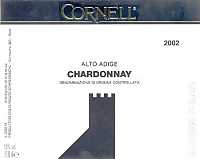
|
|
Alto Adige Chardonnay Cornell 2002 |
|
| Produttori Colterenzio (Italy) | |
| Grapes: Chardonnay | |
| Price: € 18.50 | Score: |
| This Chardonnay shows a brilliant golden yellow color and nuances of golden yellow, very transparent. The nose reveals intense, clean, pleasing, refined and elegant aromas which start with hints of hazelnut, toasted wood and banana followed by aromas of acacia, butter, coffee, pineapple, broom, passion fruit, grapefruit, vanilla, plum and praline. In the mouth has good correspondence to the nose, a crisp attack and pleasing smoothness, however well balance by alcohol, good body, intense flavors, agreeable. The finish is persistent with flavors of banana, plum and grapefruit. A well made wine. This Chardonnay ferments and ages in barrique for 11 months. | |
| Food Match: Roasted white meat, Roasted fish, Stuffed pasta, Broiled fish | |
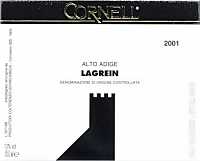
|
|
Alto Adige Lagrein Cornell 2001 |
|
| Produttori Colterenzio (Italy) | |
| Grapes: Lagrein | |
| Price: € 18.60 | Score: |
| This Lagrein shows an intense ruby red color and nuances of garnet red, little transparency. The nose reveals intense, clean, pleasing, refined and elegant aromas which start with hints of black cherry, plum and blueberry followed by aromas of vanilla, dried violet, blackberry, black currant, licorice, cocoa, menthol and white pepper. In the mouth has good correspondence to the nose, a slightly tannic attack and pleasing crispness, however well balanced by alcohol, full body, intense flavors, good tannins. The finish is persistent with flavors of black cherry, plum and blueberry. A well made wine. This Lagrein ages for 16 months in barrique. | |
| Food Match: Game, Stewed and braised meat, Roasted meat, Hard cheese | |
| Produttori Colterenzio - Schreckbichl - Strada del Vino, 8 - 39050 Cornaiano, Bozen (Italy) - Tel. +39 471 664246 Fax. +39 471 660633 - Winemaker: Wolfgang Raifer - Established: 1960 - Production: 1.200.000 bottles - E-Mail: info@colterenzio.com - WEB: www.colterenzio.com |
Cellar Journal |
|
This section is reserved to wine producers who want to publish news and information about their business, to announce new products or just for communicating to its customers information and promotions about their products and activity. Send news to be published at our e-mail address.
|
News |
|
In this section will be published news and information about events concerning the world of wine and food. Whoever is interested in publishing this kind of information can send us a mail at our address.
|
The Taste of FoodTasting food means, just like for wine, understanding and analyzing all of its organoleptic qualities, a complex process requiring attention and concentration |
|
Eating, sampling and tasting are three activities - despite they all are connectect to food - having completely different goals. The main goal of the act of eating is nutrition, an essential condition which ensures the keeping and development of life. Indeed, eating - besides its most essential role - can also become a disorder or pathology where the food is not considered by the subject for what it really is, such as in case of compulsory eating or disorders related to the rejection of food. In both cases, food is not considered for its nature and its quality: every food is capable of satisfying these disorders or pathologies. The act of eating - as a matter of fact - can also be done absent mindedly, without requiring particular attention saved the essential physical activity, not even the consciousness of what it is being put in the mouth: most of the times other actions having nothing in common with eating are done at the same time, such as walking, reading or watching the television. Sampling a food requires a minimum dose of consciousness and attention from the one doing this action. Sampling - that is consuming a small quantity of food in order to evaluate its taste - forces an individual to analyze many qualities in order to understand its characteristics, even though in a pretty approximate way. For example, a food is sampled during its preparation in order to evaluate whether the quantity of salt is enough or to verify the end of cooking. Tasting certainly is more complex because requires a complete attention and consciousness in order to evaluate every single aspect of food - appearance, aroma and taste - and this practice is done during the entire consumption of food, not only to a small part of it, such as in case of sampling. Tasting is always done in a conscious way with the explicit goal of determining and recognizing the qualities and characteristics of a food in its wholeness and in every sensorial aspect: sight, smell, taste, tact and, last but not the least, hearing.
|
|
Taste is a pretty complex sensorial quality and it is the result, among other things, to the perception of fundamental tastes and aromas perceived from the rear side of the nose. The sense of taste therefore involves the sense of smell and without its contribution it is practically impossible to recognize, for example, an orangeade from a lemonade. In fact, when a subject is affected by cold usually believes he or she is not able to recognize tastes. The gustatory qualities of food are usually associated, according to a theory older than one century, to four fundamental tastes, however - as it was widely proven - there is also a fifth taste, today known worldwide with the name umami, discovered in Japan in 1908 by Dr. Ikeda who was successful in isolating this component in Konbu seaweeds. The explanation of umami taste is pretty complex, in particular the way it is perceived by the gustatory sense, however it is absolutely proven it is contained in variable quantities in many foods - including the typical foods of western cultures - where it is still considered skeptically and even discredited, sometimes believed to be cause of some disorders.
The classical theory about the physiology of taste recognizes the existence of four fundamental tastes - sweet, salty, sour and bitter - each being perceived by specific areas of the tongue by means of gustatory receptors, also known as taste buds. The most modern theories - besides having scientifically proven the existence of umami - have also proved that every fundamental taste is detected by the tongue, although the sensitivity to each taste is higher in specific areas. Whether it is true it is simple to explain the taste of the four fundamental tastes, it is pretty complex to explain the one of umami, it certainly is complex to explain to western people because they are not very used to this taste although it has been always present in their foods since the most ancient times. The taste of umami is very evident for eastern people because they have always recognized it and used to enrich and season their foods, such as in case of soybean sauce or the countless sauces made of fish or crustaceans. The main responsible of umami taste is sodium glutamate - usually defined in the west as savor exalter - frequently considered noxious or even cause of disorders, such as the so called Chinese restaurant syndrome. This theory - besides having no foundation - cannot even be proven in practice, as many of the foods we usually consume since centuries contain this element in huge quantities and never caused any negative effect. An example is offered by hard cheese and in particular Parmesan cheese - naturally rich in sodium glutamate and other components responsible of the umami taste - which are eaten by many with no negative effects and certainly with extreme satisfaction. Despite it is not our intention to offer a comprehensive and scientific explanations of the umami taste, it is however interesting to recognize its presence and its role in taste and in the agreeability of foods. It is not by chance the most tasty foods are the ones rich in umami taste, such as Parmesan cheese or pizza, as to mention two examples. Recognizing the umami taste is not easy - in particular for the ones not used to it - and as far as this can be useful, it was sometimes defined as a “savory and pleasing taste, similar to the one of meat broth”. A certainly reductive description which however may help to recognize it, after all, talking about tastes - that is about exclusively sensorial and emotional qualities - words do not help that much and provide just a vague idea. Things certainly are easier when the four classic fundamental tastes are concerned, whose union, in different proportions, contributes to the creation of taste - and we dare to add to the umami as well - also thanks to the indispensable and precious role of smell. The most sensitive area of the tongue to the sweet taste is the tip, whereas the salty taste is mainly perceived in the middle-outside part of the tongue and just behind the tip. The area of the tongue most sensitive to sour taste is the middle-inside part, towards the center, whereas the bitter taste is mainly perceived in the back part of the tongue. As opposed to the classic theory of taste in which the perception of fundamental tastes is exclusively reserved to specific areas of the tongue, modern researches have proven the perception is possible in the whole surface even though with different sensitivities. The areas usually considered responsible to the perception of each taste are indeed more sensitive in quantitative terms: this makes one believe the perception of a specific taste is exclusively done in a specific area of the tongue.
|
||||||||
|
Taste - in its wholeness - is the result of many factors and that go far beyond the simple recognition of the fundamental tastes mentioned above. We already said a fundamental role is played by the sense of smell and in particular by the aromas that arrive to the olfactory bulb from the rear, fundamental in order to complete the recognition and the agreeability of foods. However taste is also completed by other factors having no direct connection neither with taste nor with aromas. These gustatory qualities are determined by physical factors of food and by physiological responses according to specific stimuli and conditions. Physical qualities of food allow the distinction - for example - of a beverage or a liquid food from a solid one, therefore recognizing a specific volume and consistency, factors which contribute in a fundamental way to the psychological recognition of a food. For example, if we consider an apple and an apple juice - in which the taste is practically the same - in both we can recognize the taste of apple even though we are aware of the fact it is not the same thing. The physiological responses are caused by elements considered irritating or noxious for the oral cavity, therefore the body gets ready in order to react with appropriate defenses. We can, for example, imagine a particularly sour food, such as lemon juice and to the physiological response of the oral cavity. The perception of the sour taste is evident, however this excessive acidity causes a sudden and abundant salivation as the most appropriate defense is dilution. We can also think about other reactions caused by drinking alcohol: the burning and caustic sensation of alcohol cannot be considered as a real taste, however it contributes to the definition of its taste and to its recognition. These characteristics of food, defined as tactile, are generally perceivable in the entire oral cavity, in the palate, in the upper and lower side of the tongue, in the gums and even in the esophagus and in the stomach. Another factor contributing to the definition of taste is temperature of food. This tactile characteristic also modifies the quality and the intensity both of taste and of aromas, such as, for example, the aroma and the taste of fresh baked bread and cold bread. The quantities and intensities of fundamental tastes - sweet, salty, sour, bitter and umami - contribute to the definition of tastes that can be considered as in betweens. If we examine a tomato, no one would define this food as sweet or sour. If we analyze its taste carefully, we can discover tomato has a certain sweetness and a certain acidity, even though not in quantity that would make us consider it completely sweet or sour. Despite these primary tastes are nor dominant, they however contribute to the definition of taste, therefore it is always recommended to evaluate the intensity and the strength of every stimulus produced by primary tastes. Practice, curiosity and proper concentration, will let the scrupulous taster to discover that every food is indeed made of all fundamental tastes and in different quantities: it will be discovered, for example, that even in those foods defined as sweet it can be perceived a bitter taste and even a salty taste. In other words, it is recognized as “sweet” a food in which this primary taste is present in pretty high quantities in proportion to all the others. Using particular ingredients - such as spices and aromatic herbs - as well as using specific cooking techniques, contribute to the creation of taste. Aromatic herbs - used in cooking since thousands of years - play a primary role on the aromatic part of the food, however they also add their flavors, of which the most frequent is bitter, in particular when are used during the cooking of foods. The cooking technique strongly influences taste because of the chemical alteration of the many ingredients, such as in case of sugar, that from a sweet taste can also get a bitter taste or however slightly bitter. The contribution of the cooking technique in foods is clearly and directly found in taste and in the consistency of foods: the gustatory differences, for example, of raw, steamed and broiled zucchini are common to everyone. Smoking - a technique used to preserve foods - plays a fundamental role in the alteration of taste, even though the aromatic qualities of foods are the most easy to perceive. Some tactile properties of food, besides being characteristics for their recognition, play a fundamental gustatory role in order to appear as a dominant quality. Fatty foods are recognized as such thanks to the typical sensation found in the mouth when these foods are being eaten, capable of literally cover the oral cavity therefore diminishing in many cases the perception of fundamental tastes. A pretty similar role is played by unctuous foods - far different from fats because of the different consistence perceived in the mouth - and besides having their own tastes, they also tend to have a pretty evident viscous and slippy action thus altering the perception of tastes. As an example and in order to better understand the tactile sensorial qualities of fat and oils, it can be evaluated the differences of olive oil, butter and lard. Another tactile characteristic that can sometimes modify the perception of tastes is stickiness, typical in jelly and proteinic foods, such as the Italian zampone and other foods made of meat and prepared with particular cooking techniques, such as in the case of stews and braises. Among tactile qualities of taste is also found succulence, that is the sensation caused by an abundant quantity of liquids in the oral cavity during the chewing process. Succulence is caused by direct and indirect factors. Direct succulence is caused by liquid substances and juices released by food - including sauces used for cooking - whereas indirect succulence is caused by the physiological reaction of salivation. It is good to observe that every food causes salivation, however specific properties favor a higher secretion, such as in case of sour substances and proteins. tasting food is a complex process requiring total concentration and attention because the factors determining taste are many and work together for its definition. It would certainly be a good habit to always taste food instead of simply eating: in this way not only it is favored the quality of nutrition - and therefore of life - and it would certainly help to avoid many insignificant foods that most of the times have the quality of being eaten with eyes only.
|
||||
GarlicProbably coming from the Middle East, very used in cooking both raw and cooked to seasoning foods, appreciated as a remedy as well as for its preventive properties against many diseases |
|
Garlic is a plant having countless beneficial properties, considered by ancient Egyptians as a god. Both used as a food and as a remedy, it is traditionally an indispensable ingredient of the cooking in every country of the world as well as a remedy for the body. Allium sativum belongs to the liliaceae family, it is a perennial herbaceous plant with a bulb containing cloves, that is the part mainly used. Leaves are attached to the base, about one centimeter wide getting thinner towards the tip. Flowers, gathered to the top of the plant, are closed, before blossoming, in a bract covering the whole flower and are made of six whitish colored petals. Sometimes in flowers are also found small bulbs and as they fall on the ground - provided they also find a proper environment - may give origin to new plants. The plant of garlic does not grow wild and it is cultivated in every tempered area of the world, industrially produced because of its wide use in cooking. There are many varieties: some having bulbs with a white colored skin, called common garlic, other with a pink or mallow colored skin, known as red garlic. Bulbs can be of many sizes, as well as the size and the number of cloves contained in them. The aroma changes according the variety and the climate: there are varieties of garlic with sweet and delicate taste with an aroma similar to walnuts; other are strong with a pungent aroma. The best garlic comes from warm climate countries. Garlic is not a very demanding plant: its cultivation requires a rich, light and well drained soil and plenty of sun.
|
|
Garlic probably comes from the Middle East, known and appreciated since the ancient times, both as an ingredient to season foods and sauces, as well as a remedy. It was used by Chinese, Babylonians, Arabs and Egyptians. Hebrews walking towards the promise land, missed Egyptian garlic. The most ancient written evidences about garlic are in Sanskrit language, where it was defined as “the killer of monsters”, even though the first useful information are found in an Egyptian papyrus - the Codex Ebers dated back to 1550 BC - about twenty meters long and containing hundreds of medical prescriptions. Garlic is mentioned in about twenty prescriptions mainly as a remedy against insect stings, to relief headache and as a relief for pain. In Egypt garlic was considered as a sacred plant and was given to slaves involved in hard works in order to improve their stamina.
In the tomb of Egyptian pharaoh Tutankhamen have been found bulbs of garlic probably left there in order to keep away evil ghosts. The medical knowledge of the Egyptian tradition was assimilated by Greeks, who filtered all the magic formulas while keeping the practical parts only, that is the medical prescriptions, the preparations and the techniques. Hippocrates, one of the greatest physicians of ancient times, based his theories by observing facts and recommended the use of garlic for its medical qualities, guaranteed by the Egyptian tradition and popular experience. Greek athletes consumed garlic before competitions. During the times of Roman Empire, and precisely in the first century before Christ, Roman legionaries used garlic as a remedy against infections and vermifuge, likewise Gauls ate garlic before fights. In ancient Rome the Latin expression allium olere (stinking of garlic) was used to refer to people belonging to a lower social class. Pliny the Elder in his Naturalis Historia, taught with detailed prescription about the many therapeutic uses of garlic. Other ancient authors mentioned the properties of garlic, including Ovid, Herodotus, Terence and Varro. According to a legend, during the epidemic of pestilence in Europe around the fourteenth century, only frequent garlic consumers were saved from the contagion. An important reference point in history is mentioned in a manuscript of the sixteenth century, known as “Erbario di Urbino” (Urbino's Herbarium), in which is found an excellent collection of empirical knowledge and popular traditional medicine about the therapeutic properties of plants. So far all the documents are based on or mention traditions, superstitions and popular beliefs. A popular tradition has it that a tuft of garlic in every house offers protection against evil ghosts. During renaissance, garlic was kept away and even banned from the tables of noble people, because of the bad smell it gave to breath, to sweat and intestinal gases. The first scientific information - in the way we recognize them today - are dated back to 1858. Louis Pasteur, important French figure in the history of chemistry thanks to the process of pasteurization and of medicine for his researches about microbes, scientifically determined the antibiotic qualities of garlic. Albert Schweitzer, the famous organ player, Nobel prize and physician, has spent many years of his life to cure the least lucky people of Africa: he used garlic as a remedy for dysentery and against tuberculosis, typhus and diphtheria. In China, where garlic is consumed by at least three thousand years, are being conducted some researches about its medical properties in the province of Shandong, where the local people - since a very long time - are big garlic consumers. It seems that eating this plant as well as other liliaceae, contributes to lower the risk of cancers.
|
||||||||
|
Before listing the beneficial and medical properties of garlic, it is good to remember that when plants, vegetables and fruits are mentioned, most of the times are emphasized their beneficial and therapeutic properties for the body. It is good to remember these benefits are not to be considered as real medicines. Therefore, by saying garlic is good against hypertension, this does not mean it must be used instead of the pills prescribed by the doctor, it means a regular consumption helps to relief this problem. By considering pharmaceutical industry is very attentive to the research of a “truly working” active substance, in case it was discovered it would certainly be started its industrial production, in case the product does not contain active substances in relevant quantities, but only at a level of “coadjuvant”, it is ignored and relegated to the group of food integrators. The best quality garlic is hard, with cloves joined together to the cartilaginous membrane with no uncolored stains. In case some cloves with uncolored stains are found - this may happen in some seasons - it is better to eliminate them with a knife as the taste in this spots is bad and can easily ruin any preparation. Garlic is famous for its unmistakable aroma, because of a substance contained in its bulbs. As the clove is cut, this substance gets combined with an enzyme therefore giving origin to its characteristic aroma. Garlic is an efficient antiseptic and improve the resistance of the body against infections. Garlic helps to alleviate atherosclerosis, diabetes and all the pathologies in which are involved free radicals. Ayurvedic medicine considers garlic a good remedy against leprosy. Garlic juice is rich in potassium, therefore it helps to keep blood pressure low. Popular tradition believes garlic is useful as a remedy for cholesterol, triglycerides, dysentery, constipation, diabetes, tracheitis, pharyngitis, tonsillitis, asthma, cold, sinusitis, catarrh, cysts and insect stings. In ancient times is was used - as a remedy for rheumatism - the vinegar of four thieves, obtained by macerating garlic and thyme in vinegar. In order to make garlic more digestible, as well as keeping almost unaltered its fragrance, it is good to cut the clove along its longest side and to completely remove the central part. Moreover, it seems that chewing some leaves of parsley helps to eliminate the bad smell of the breath after having eaten garlic. Garlic is not a panacea and it should not be consumed by anyone as it has some contraindications. Garlic must not be consumed in case of gastritis, stomach and duodenal ulcers, excess of acidity - because of its stimulating effect on the secretion of gastric juices - in case of pregnancy or breast feeding, irritations of the stomach and bowl, gastric irritations, hypotension and diseases of the skin. Raw garlic is found worldwide in many cooking recipes such as garlic butter, garlic oil, aïoli - a characteristic sauce from southern France and Spain - Skordalia - characteristic in Greece - and the renowned pesto alla Genovese. Garlic is also used in the cooking of European countries, in the Middle and Far East, in Africa, India, North and South America. It certainly is easier to list the recipes in which garlic is not found instead of the ones in which it is used. Its taste is well amalgamated with every type of meat, game, fish, crustaceans, mushrooms and most of vegetables. Some use garlic with mushrooms in order to enhance aromas. Garlic - besides onion - is one of the most used ingredients found in every cooking culture of the world.
|
||||
|
The nutritional contribution of garlic in human feeding is not significative, mainly because it is usually consumed in small quantities. According to a nutritional point of view, 100 grams of garlic contain: 41 KCal, of which 9% proteins, 13% fats and 78% carbohydrates. The chemical composition contains 80 g of water, 0.9 g proteins, 8.4 g carbohydrates, 0.6 g fats, 3.1 g fibers and 0 g cholesterol. Vitamins contained in garlic are A, B1, B2, B3, C and E. The content in mineral is 1.5 mg iron, 14 mg calcium, 63 mg phosphor, 600 mg potassium.
|
AquavitaeReview of Grappa, Distillates and Brandy |
|
|
| Distillates are rated according to DiWineTaste's evaluation method. Please see score legend in the "Wines of the Month" section. |
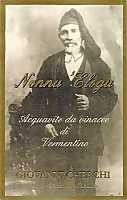
|
|
Nonnu 'Elogu Bianca |
|
| Giovanni Cherchi (Italy) | |
| (Distiller: Distillerie Berta) | |
| Raw matter: Pomace of Vermentino Tuvaoes | |
| Price: € 14.50 - 50cl | Score: |
| This grappa is colorless, limpid and crystalline. The nose denotes intense, clean and pleasing aromas of pear, raspberry, broom and hazelnut, almost imperceptible alcohol pungency. In the mouth is intense with alcohol pungency which tends to dissolve rapidly, perceptible sweet taste. The finish is persistent with flavors of pear, raspberry and a sweet hint. Alcohol 40%. | |
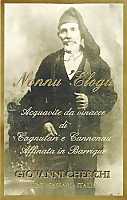
|
|
Nonnu 'Elogu Ambrata |
|
| Giovanni Cherchi (Italy) | |
| (Distiller: Distillerie Berta) | |
| Raw matter: Pomace of Cagnulari and Cannonau | |
| Price: € 14.50 - 50cl | Score: |
| This grappa shows a brilliant amber yellow color, limpid and crystalline. The nose reveals intense and clean aromas of praline, plum, vanilla, licorice, blueberry and banana. In the mouth is intense and agreeable with alcohol pungency that tends to dissolve rapidly, agreeable sweet hint. The finish is persistent with flavors of praline, licorice and banana. This grappa ages in cask. Alcohol 40%. | |
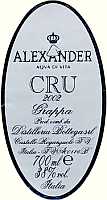
|
|
Grappa Alexander Cru 2002 |
|
| Distilleria Bottega (Italy) | |
| Raw matter: Pomace of Prosecco and Muscat | |
| Price: € 14.73 - 70cl | Score: |
| This grappa is colorless, limpid and crystalline. The nose reveals intense, clean and pleasing aromas of walnut, banana, pear, plum, broom, raspberry, black cherry, hay, hazelnut, lavender and white melon with almost imperceptible alcohol pungency. In the mouth is intense with immediate perception of alcohol even though tends to dissolve rapidly, well balanced sweet hint. The finish is persistent with flavors of walnut, pear and hazelnut. A well made grappa distilled in steam operated alembics. Alcohol 60%. | |
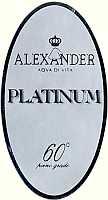
|
|
Grappa Alexander Platinum |
|
| Distilleria Bottega (Italy) | |
| Raw matter: Pomace of Amarone and Recioto (Corvina, Rondinella, Molinara) | |
| Price: € 19,50 - 70cl | Score: |
| This grappa is colorless, limpid and crystalline. The nose reveals intense, clean and pleasing aromas of walnut, banana, pear, plum, broom, raspberry, black cherry, hay, hazelnut, lavender and white melon with almost imperceptible alcohol pungency. In the mouth is intense with immediate perception of alcohol even though tends to dissolve rapidly, well balanced sweet hint. The finish is persistent with flavors of walnut, pear and hazelnut. A well made grappa distilled in steam operated alembics. Alcohol 60%. | |
Wine Parade |
|
|
| The best 15 wines according to DiWineTaste's readers. To express your best three wines send us an E-mail or fill in the form available at our WEB site. |
| Rank | Wine, Producer | |
|---|---|---|
| 1 |
| Harmonium 2001, Firriato (Italy) |
| 2 |
| Montepulciano d'Abruzzo Villa Gemma 1999, Masciarelli (Italy) |
| 3 |
| Riesling Cuvée Frédéric Emile 1999, Maison Trimbach (France) |
| 4 |
| Pinot Noir Napa 2002, Clos du Val (USA) |
| 5 |
| Turriga 1998, Argiolas (Italy) |
| 6 |
| Chablis Grand Cru Les Clos 2002, Domaine Billaud-Simon (France) |
| 7 |
| Amarone della Valpolicella Classico Capitel Monte Olmi 1999, Tedeschi (Italy) |
| 8 |
| Brunello di Montalcino Prime Donne 1998, Donatella Cinelli Colombini (Italy) |
| 9 |
| Jerez Fino Tio Pepe, Gonzalez Byass (Spain) |
| 10 |
| Moscato d'Asti 2003, Vignaioli di S. Stefano (Italy) |
| 11 |
| Palazzo della Torre 2000, Allegrini (Italy) |
| 12 |
| Notarpanaro 1999, Taurino (Italy) |
| 13 |
| Barolo Cicala 1999, Poderi Aldo Conterno (Italy) |
| 14 |
| Edizione Cinque Autoctoni 2001, Farnese (Italy) |
| 13 |
| Montepulciano d'Abruzzo Riparosso 2001, Illuminati (France) |
| |||||||
Privacy Policy | |||||||


| Copyright © 2002-2024 Antonello Biancalana, DiWineTaste - All rights reserved |
| All rights reserved under international copyright conventions. No part of this publication and of this WEB site may be
reproduced or utilized in any form or by any means, electronic or mechanical, without permission in writing from DiWineTaste. |